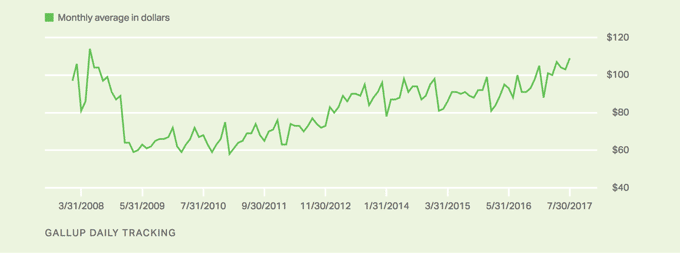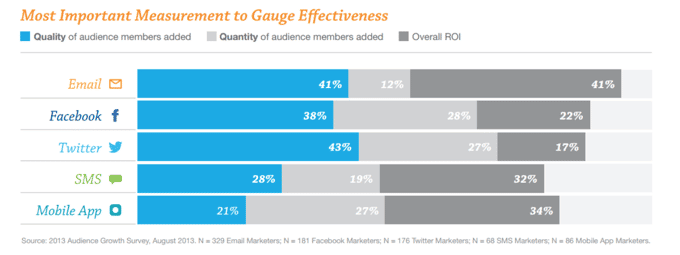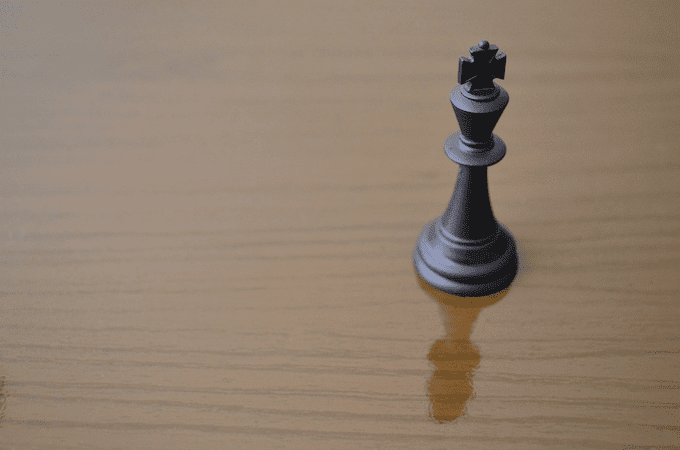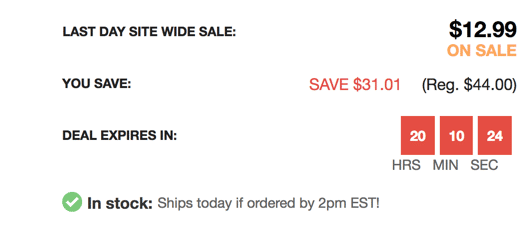Data from U.S consumer monitors demonstrates a distinct spending peak in certain seasons. Even amidst the 2008-2009 recession, the average spending always went up around new year and Christmas season.

Optimizing your website for conversions around peak seasons will give you an additional boast and generate higher revenues.

There are few basics premises that you should keep in mind while creating campaigns during the holidays:
- Customers are more motivated during the holidays thus they are more forgiving and willing to overlook many small fears, uncertainties and doubts (FUDs) on your platform (website or mobile app)
- Understanding customers’ psychology and their motivation during the holiday will help you create offers that match their needs
- Strong messaging that resonates with visitors can have strong impact with your website visitors
- Fortify your messaging with the incentives that work for your target market
This post should give you a good starting point to create your campaigns, drive traffic and convert that traffic into customers.
Step 1: Start with holiday messaging to build a strong conversion strategy
Creating the right campaign messaging assumes that you already did your homework and defined your marketing segments and created customer personas for these segments. Here are some questions you should consider:
- What are the different special occasions which your potential customers celebrate?
- What is a unique offer you have for these occasions?
- What is the are the some of the common features your customers will evaluate when buying your product/offer during that occasion?
- Of all the different features you listed, what are the top 3 features most important for your customers?
- What is the differentiating factor between you offer and all other competing offers on other websites?
- What is that one thing; the key, that will “wow” your customers into buying from you?
The last question about “wowing” you customer is the most difficult question to answer.
There are many times when we overthink that question, yet the answer is simple and in front of our eyes.
Amazon prime is a perfect example of this. There is nothing amazing about free two-day shipping.
But it is genius.
Amazon prime attempts to satisfy the need for instant gratification that we consumers have.

Your goal is to identify the most relevant offer for the right customer segment. One customer segment might decide based on price, others based on delivery, or packaging.
Your competitors might have the same offer, however the messaging around the offer plays an important role in the way customers perceive it and value it.
As you create your campaign offer, try to avoid some of the following mistakes:
- Do not rely on lower pricing, discounts or free shipping as the heart and soul of your offer. Just about anyone can offer discounts. And even though those factors might give you a push over your competition, they are less likely to be a sustainable long term strategy.
- A satisfaction guarantee might look good in theory but it has been so over used that it rarely (if ever) resonate with potential customers.
The best offer is the one that drives its inspiration from your value proposition.
Sand is free
A few years ago, I was on a trip to a beach on the west -cost. I stumbled on a street seller who was offering small plastic bags filled with beach sand for $5 a bag.
This might seem very illogical at first. But his customers were coming and going. And then I noticed the sign above the sandbags, “Sand is free, memento is priceless”.
This man was bringing in the sales even though his customers could have filled in the bags themselves. He was selling them the memory of being on the beach. That was a unique way of defining his product value that resonated with his customers.
Create different messaging for different peak seasons:
- For Mother’s Day, you need to focus on gifts for Moms who given us children so much of their love, time, and energy.
- For Christmas, you need to focus on messaging around sharing and connecting with others
- For Valentine’s day, you need to focus on gender specific messaging.
Also, try to create different messaging for different budget levels.
Step 2: determine how to drive traffic to your campaign

The most amazing campaign is useless unless your target market knows about it.
Your existing customers will generate the highest ROI for your campaigns. They have already purchased from you, and you already established some level of trust with them. Take a look at customer acquisition vs. retention costs.
Closely behind your existing customer base comes your previous website visitors. They’re already familiar with your brand, and perhaps your offer during the peak season will be the final straw to turn them from lookers to converters.
Business Insider states that returning visitors are almost twice as likely to convert to customers:

There are four main ways to create awareness for your campaign:
- Use email marketing
- Use paid channels
- Retargeting ads
- Influencer marketing
1. Email marketing during the peak seasons

Email remains as the most effective marketing channel for B2C websites. On average, email conversion rates are anywhere from 3x to 5x compared to other sources of website traffic.
Stats show double the ROI when comparing emails to social media channels:

Conversion rates for emails sent to previous websites visitors is equal to the conversion rates from all social media campaigns combined.
We discussed in the past how to create ecommerce emails that help you increase your conversion rates.
Email subject line
What is the worst that could happen to your email marketing campaign?
Going un-noticed, and unopened. Maybe it ends up in the social tab in Gmail or the junk folder.
Your email battle starts at the subject line. And the very first metric you should focus on is email open rate.
Your subject line should be short and to-the-point, and at the same time should include important value to the recipient.
Here are a few tips on how to right a compelling subject line:
- Minimize the number of links you use in the email body. It has been our experience that emails with more than 2 links end up in the promotions tab in Gmail.
- The first 3 words matter. They will determine whether the reader will finish the sentence or not. Mention the value of the offer in the first 3 words. For example, “50% discount on…” or “Free shipping for all…”
- Throw in an urgency incentive for the viewer to open. “limited stock” or “valid until Feb 4th”
- Testing using emoji’s in the middle or end of the subject line and see what impacts they have on open rates.
- Test using different sender names and how that impacts your open rates.
Email content
Your first battle when it comes to email marketing is increasing your open rates. The next battle is to persuade those visitors who opened the email to click through to your website.
Your email content should clearly state your value proposition and incentive. Your email design should support your value proposition as well.
Whether it was a bundle sale, or a fast shipping offer, have it professionally designed with a clear CTA. With one click on that big button (or even banner), the visitor will jump into your landing page.
Email scheduling
Your email campaigns should start 30 days out before the campaign close out date.
The first email which kicks off the campaign should remind your list of the upcoming holiday and encourage them to start the shopping process.
We typically recommend continuing the campaign at the rate of one email per week until the last week, where emails can get a bit more aggressive where we do 2-3 final chance emails.
Segment your list

At a minimum, you should segment every email campaign into three buckets:
- Those who opened the email but did not click through
- Those who clicked through the email but did not place an order
- Those who placed an order
You can of course get a lot more granular in your segmentation looking at things such as previous purchase history or website visitor behavior. An example of this would be:
- Those who placed x number of orders in the last six months, clicked through on the email but did not place an order
- Those who placed an order with an 2x your average order value, clicked through on the current email campaign but did not place an order
Some of these segments might be difficult to track with standard email platforms and would require custom development. If you have the budget, they are worth the investment.
Prepare your last chance to get a gift

Based on shipping times and item availability, you should create a “last chance email” giving your email list a last chance to place an order.
Do not offer any special discounts for customers who wait until the last moment. We have seen stores fall into that mistake thus training some of these customers to hold off until the last moment hoping to get a discount.
2. Run paid traffic campaigns
Potential customers are highly motivated during peak seasons. Paid campaigns that might not work all too well during the rest of the year typically generate good ROI during the holidays. Find out where your customers hang out and run your ads there. That could be Google, Instagram, Facebook, twitter, etc.
If you read our book on conversions optimization, you know that back in 2010, we were big fans of using social media to drive website traffic.
Things have changed in the last few years.
Most of our clients drive significant results from running Facebook ads. And the few B2C clients who are not able to figure out how to generate positive ROI from social media are either using the wrong platform for their business or they lack the experience in running campaigns on these platforms.
3. Retargeting ads

I wanted to call out retargeting ads separately from other paid ads because they can provide great value during the holidays. You have a higher chance of converting someone who already visited your website and knows your brands. You should be running retargeting ads all the time, but it is even more important to run them during peak season.
When creating re-targeting campaigns, make sure to create different messaging for visitors based on the pages or sections they have visited on your website. Someone who only visited your homepage should see different messaging/ads compared to someone who added items to his basket.
4. Influencer marketing

Again, your goal is to drive awareness of your campaigns. Finding the right Influencer will can translate into driving highly motivated visitors to your website.
The trick here is to find the right influencer, make sure that their following is your target market and that their engagement metrics are real and substantial. There are Instagram influencers with 10% engagement others with 1%. You should allocate a little bit of a budge to test this strategy and see how it impacts your bottom line.
Bonus tip: consider using SMS (if you have collected phone numbers and permission) to drive awareness to your campaign.
Step3: On site Conversion Rate Optimization

We discussed campaign messaging and how to drive traffic to your campaign. The final piece of the puzzle is how to convert that traffic that comes to your website.
Marketing experiments conversion formula emphasizes the importance of motivation giving it the highest value:

Customers are typically highly motivated during peak season. That means that they are more forgiving of many of the mistakes that cripple your conversion rates during off seasons. With motivated visitors, you have two main goals:
- Reduce visitors’ FUDs
- Incentivize visitors to act immediately
Here are some of the strategies and tactics you should use:
Addressing this in the early stage of their purchase (as early as the landing page) will result in lowering the buyer anxiety and bring in more sales. In one of our case studies, we saw that Reducing Visitor Anxieties Increased Conversion Rate By 108%.
1. Create a custom homepage design for peak seasons
If there is a time in the year to update the design of your homepage, it is during peak seasons.
Walmart sets a good example during valentines:

If you have a special offer for a peak season, make sure visitors can see it.
But it does not have to stop at offers. Sometimes highlighting the set of products that relate to the particular holiday is enough to increase conversion rates. By highlighting categories that relate to Veteran’s day and Christmas, we were able to generate a 12% uplift in conversions rates for one client:

GiftTree announces the holiday gifts are ready to be ordered with a banner on their homepage:

The problem is that the banner blends in with everything else on the page.
You can also go for an overall discount on any holiday related gift:

2. Use incentives to drive visitors’ action
We published previously how helped a Billion-Dollar Company Increase Conversions by 6.89% through incentives.
Let’s go into detail about the different kinds of incentives and how can you can utilize them.
Incentives: create a sense of urgency
Urgency is one of the most powerful human emotions. It prompts people to act, and drives them to act quickly – now!

Notice the messaging that hotels.com uses: “our availability in Dublin is low on your dates.” They are using simple copy to increase visitors’ sense urgency to the visitor.
The discount badge of “45% off today” is another urgency tactic.
“Lock this great price while you still can” again creates a sense of urgency.
Timer countdowns are another way to increase the visitors sense of urgency:
Use a combination of urgency and free shipping to create the sense of urgency.

Using a combination of urgency and discounts to encourage visitors to convert:

In the following example, we used several incentives on this website to increase conversion rates:

- “LAST DAY SITE WIDE SALE” – urges visitors to act today to get the discount.
- “DEAL EXPIRES IN:” – again persuading visitors to act right away
- “Ships today if ordered by 2pm EST!” a 3rd urgency tactic to get visitors to act.
Incentivizing visitors to act through scarcity
Showing your visitors how many items are left in stock can be a powerful motivator. The decreased abundance of any given item can increase its value.
When a customer asked about why Amazon tells customers “X is left in stock”, someone answered:

going back to the example from hotels.com:

Notice the “booked 26 times today”, “only 4 rooms left on our site”, and “you missed it”, they all send a very strong message of scarcity to the website visitor. They are screaming at him to act immediately.
Johnlewis.com might be missing on some sales because their scarcity incentive isn’t highlighted enough:

Incentive: Discount Bundles and Personalization
Fact: 73% of online shoppers look for discounts/promos.
Discount offers such as percentage based discount, free gifts or free shipping are very likely to increase conversions and customer loyalty.
Our data shows the top factors that influence holiday shopping:

You can also check out those 14 Ways to Use Offers, Coupons, Discounts by Richard Lazazzera.
Make sure that offer is visibly clear, in a way that no visitor would miss it.
1800flowers.com does a great job with this:

Notice the following:
- Discount badges on each product image
- Discount presented on price (Old price) and the Sale price is emphasized
- Product packaging and/or shipping information is highlighted on each product
Shipping time
Website visitors typically rank shipping cost and time as one of the top factors when choosing where to shop.
To increase your conversion rates, consider testing any of the following elements:
- Estimated delivery time
- Earliest delivery
- The shipping time
- Time in transit
Allowing the visitor to see clear date of delivery, based on their zip code, will help increase your conversion rates.
Of course, this assumes that you are able to ship items quickly to customers.
One of our clients that sold traditional Indian garments faced several challenges when it comes to the speed of shipping an order:
- The website offered custom tailoring that can take up to two weeks to complete
- Most of the orders are shipped internationally from India to the US. There were shipping delays due to international shipping in addition to possible delays in customs
We tested using shipping time widget generated an upwards of 12% increase in conversions.

And as soon as visitor enters the zip code, a flood of information about shipping (and in this case, payment option) are provided:

The heatmap for product pages showed a strong correlation between number of visitors who use this widget and the number of visitors who click on the “Add to bag” button.

Putting your holiday conversion plan to work
There are way too many conversion optimization principles to cover in one article. So make sure you subscribe to our latest article to stay updated.
Start today with your holiday campaign. Follow the steps in this article for the upcoming holiday season. Of course, you should keep your monitoring the effectiveness of different channels you are using to drive traffic to your website. Compare your results to last year’s season, and the numbers will talk for themselves.



